Only nine animated films have ever been nominated for the Academy Award for Best Original Screenplay; Ratatouille is one of them. There’s so much that we can learn from the Ratatouille script from plot to characters to its satisfying ending. So, cook up your best dish, download a PDF copy, and follow along as we break down the best aspects of the Ratatouille screenplay!
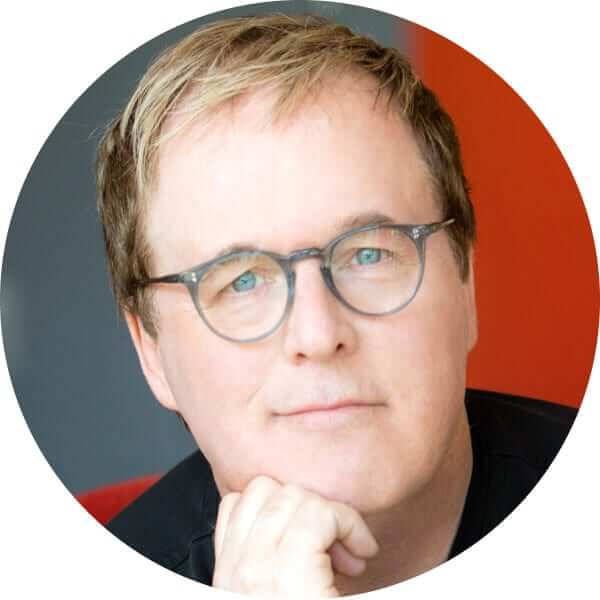


WHO WROTE THE ratatouille SCRIPT?
Written by Brad Bird, Jan Pinkava, Jim Capobianco
Brad Bird is one of the most accomplished living American filmmakers. Over 40+ years in the industry, Bird has worked as an animator, director, screenwriter, producer and voice actor. Some of his most famous works include The Iron Giant, The Incredibles, and Mission: Impossible - Ghost Protocol.
Jan Pinkava is an animator, writer, and director. He won the Academy Award for Best Animated Short Film in 1997 for his work on Geri’s Game.
Jim Capobianco is a writer and animator who has worked at Pixar for nearly 20 years. In his time with the studio, he’s collaborated on films like Toy Story 2 and WALL-E.
Ratatouille Summary
STRUCTURE OF RATATOUILLE SCREENPLAY
Here is the story structure for the Ratatouille screenplay:
Exposition
Auguste Gusteau is the most famous chef in France, but food critic Anton Ego takes umbrage with his book Anyone Can Cook! Remy is a rat who lives with his father Django and his brother Emile. He uses his refined sense of smell to protect the rat colony from poison.
Inciting Incident
Remy and Emile sneak into the kitchen of an old lady to steal food. While there, Remy sees on the TV that his idol Gusteau, has died. The old lady notices the rat brothers then chases them with a shotgun. This forces the rats to escape down the river but Remy falls behind.
Plot Point One
With the help of Gusteau’s cookbook, Remy sails down the sewer, all the way to Paris. A sprite of Gusteau leads him to his old restaurant, where he finds the head chef (Skinner), a young woman chef (Colette), and the garbage boy (Linguini).
Plot Point Two
Remy cooks up a master dish but everybody thinks it was Linguini. In turn, Linguini is made a chef, despite the fact that he has no cooking skills at all. Remy and Linguini strike a deal; Remy will do all the cooking and Linguini will get all the credit.
Rising Action
In a secret letter, Skinner learns that Linguini is Gusteau’s son and has been named the heir to the restaurant. In disbelief, Skinner has his DNA tested. It comes back as a match, but there was rat hair as well. Skinner starts to believe a rat is behind Linguini’s culinary genius.
Midpoint
Remy is reunited with Emile and goes with him to the new rat colony. While there, he argues with his father Django, and tells him that he always wanted to be a chef. Django reminds Remy that he’s a rat and to never trust the humans. Remy leaves on a sour note.
Plot Point Two
Colette helps Linguini (AKA Remy under his hat) learn Gusteau’s recipes. Over time, Colette’s rough exterior softens and she and Linguini grow closer. Eventually, they kiss and become a couple.
Build Up
Gusteau’s is revitalized and becomes the talk of the town. Remy finds out that Linguini is Gusteau’s son, so he steals the will which results in Skinner getting fired. Under Linguini and Remy’s control, the restaurant flourishes.
Build Up Two
Linguini starts to take credit for himself, which upsets Remy. In a fit of rage, Remy and the rats launch a heist on the kitchen. Linguini discovers the rats stealing all of the food and feels betrayed.
Climax
Skinner (anonymously) reports a rat infestation at Gusteau’s which prompts a food safety inspector to go to the restaurant. Food critic Anton Ego is there to review Linguini’s new work. However, without Remy, he fails.
Climax Part Two
All of the chefs leave Linguini, including Colette. On her way home, Colette sees a copy of Anyone Can Cook! and has a change of heart. She returns to help Linguini — as does Remy and all the rats. Together, they deliver their best meal yet: a stew of ratatouille.
Finale
Ego gives Gusteau’s an excellent review, and says that he was wrong to say that some people aren’t capable of being chefs. However, the restaurant is shut down by the board of health when the inspector finds all the rats in the kitchen.
Denouement
Remy, Linguini, and Colette launch a new restaurant, with funding from Ego. It’s so popular with patrons that there’s a line around the block to get in.
Ratatouille Plot and Setting
Crafting a Pixar world in Paris
If you’re familiar with Pixar, you probably know that they love to use animals, toys, and monsters to tell their stories. When stories use characters that aren’t human but act like they’re human, then we usually refer to them as fables.
Now, Pixar movies are generally not fables. They have fabulist elements, but they also have human characters. By doing this, Pixar creates a unique storytelling method that blends reality and surreality.
We imported the Ratatouille script into StudioBinder’s screenwriting software to see how the writers implemented fabulist elements to achieve this end. You’ll see throughout this scene how Remy and the rats may serve a metaphorical purpose beyond their animalistic form.
Ratatouille Screenplay • Read the Escape Scene
This is a really good scene to look at if you’re considering using any sort of allegory in your own script. Remy and the rats are expelled from their humble abode in the farmhouse attic and chased into the river.
Rats can swim, that much is certain. But by having the rat colony flee down the river like Magellan sailing down a narrow strait under fire, we really get a sense of the scene’s fabulist elements: everything is exaggerated, nothing is 100% literal, and there’s obvious conflict.
How did things come together in the final cut? Let’s take a look:
Ratatouille Plot • Escape Clip
In terms of allegorical or metaphorical meaning, what is this scene all about? Well, it’s difficult to say. As we alluded to earlier, there are fabulist elements, and they do allude to a central maxim of the story (anyone can cook). Could we try to ascertain more meaning from this scene? Absolutely, but what’s the purpose?
Pixar movies seem entirely content with raising big ideas, then letting them play out in a sensational way — Ratatouille is no exception. Sometimes scripts struggle with trying to do too much, but Ratatouille shows us that a little bit of focus can go a long way.
Ratatouille Characters
How to write characters we root for
Every story revolves around conflict, but what good is that conflict if we don’t have somebody to root for? It sounds remarkably easy, but writing characters that we “want to win” is actually very difficult.
The Ratatouille screenplay does a great job of establishing character conflict, then layering it with plot, theme, and subtext.
Let’s break down how Brad Bird and the writing team establish conflict, weave plots around it, and communicate themes and subtext through it.
Character conflict: Linguini vs. Skinner
Plot: Linguini is the rightful heir to Guesteau’s restaurant. He wants to return the restaurant to its previous prestige and the maxim “anyone can cook.” Skinner conceals Linguini’s true heritage. He cares more about making money from the restaurant than he does the art of cooking.
Theme (fabulist maxim): Anybody and everybody should have the right to cook.
Subtext: Skinner rejects this theme because he doesn’t believe Remy should be allowed to cook because he’s a rat. Consequently, Linguini embraces it.
It’s hard to blame Skinner for thinking that rats can’t be chefs. But that’s where Pixar’s signature fabulist elements come back into play: everything is exaggerated, nothing is 100% literal, and there’s obvious conflict, further aided by making us root for certain characters.
We’re going to take another look at the script to see how Ratatouille characters are written. Make sure to pay special attention to Skinner’s dialogue to hear one of the best Ratatouille quotes.
Ratatouille Screenplay • Read the ‘Soup’ Scene
How do the writers make us root for a rat cooking in the kitchen? Well, it starts with Skinner, who is just completely unlikable. When he notices Linguini altered the soup, he delivers one of the best Ratatouille quotes “Where do you get the gall to even attempt something so monumentally idiotic? I should have you drawn and quartered! I’ll do it! I think the law is on my side!”
Call me crazy, but I think that may be a bit too severe of a punishment.
Meanwhile, we really want Remy and Linguini to win, largely because their ideals are more noble, and wholesome. All of this conflict is further supported by the visuals and voice performances. Let’s look at the scene from the movie to see how it all comes together:
Ratatouille • ‘Drawn and Quartered’ Clip
Notice anything about the visual design of the Ratatouille characters? Well, Linguini and Remy look pretty meek. We’re naturally inclined to root for people (or rats) who are on the defensive, so long as we think they didn’t do anything wrong. On the other side, Skinner looks very angry, but he shouldn’t be. This makes us view him in a villainous light. All of this comes together to build clear and nuanced character conflict.
Ratatouille Ending
Conclude with the central message
The Ratatouille screenplay revolves around Gusteau’s Anyone Can Cook! cookbook. This is the object that inspired Remy to be a chef, saved him from drowning, and proved that even though he’s a rat, he can cook too.
Oftentimes, these central objects are difficult to understand without story context — think Rosebud in Citizen Kane. But remember, Ratatouille is a film for all ages, so the cookbook serves a universal message that can easily be understood on its own.
Let’s see how the writers tied a bow on the Ratatouille ending with character resolution, plot conclusion, and a very special callback to the title of the film.
Ratatouille Screenplay • Read the Ending
Anton Ego was the biggest critic of Guesteau’s maxim “anyone can cook” but in the end he became its biggest advocate. By doing this, the writers found a great amount of resolution, not only for their characters, but for their themes as well.
And of course, Pixar did a tremendous job of swelling our emotions with visuals and music. Let’s take a look:
Ratatouille • La Ratatouille Restaurant Clip
Everybody who watches film, from the casual viewer to the critic can appreciate good resolution. Few animated films use conflict, plot, and themes to find resolution better than Ratatouille.
Related Posts
UP NEXT
Read and Download More Scripts
Ratatouille is a love letter to Paris, a valentine to the fine art of cooking, and a gift to film fans of all ages. If you want to read more great scripts, we have The Lion King, Frozen and Coco in our screenplay database. Great screenwriters read lots of scripts. Get started today!

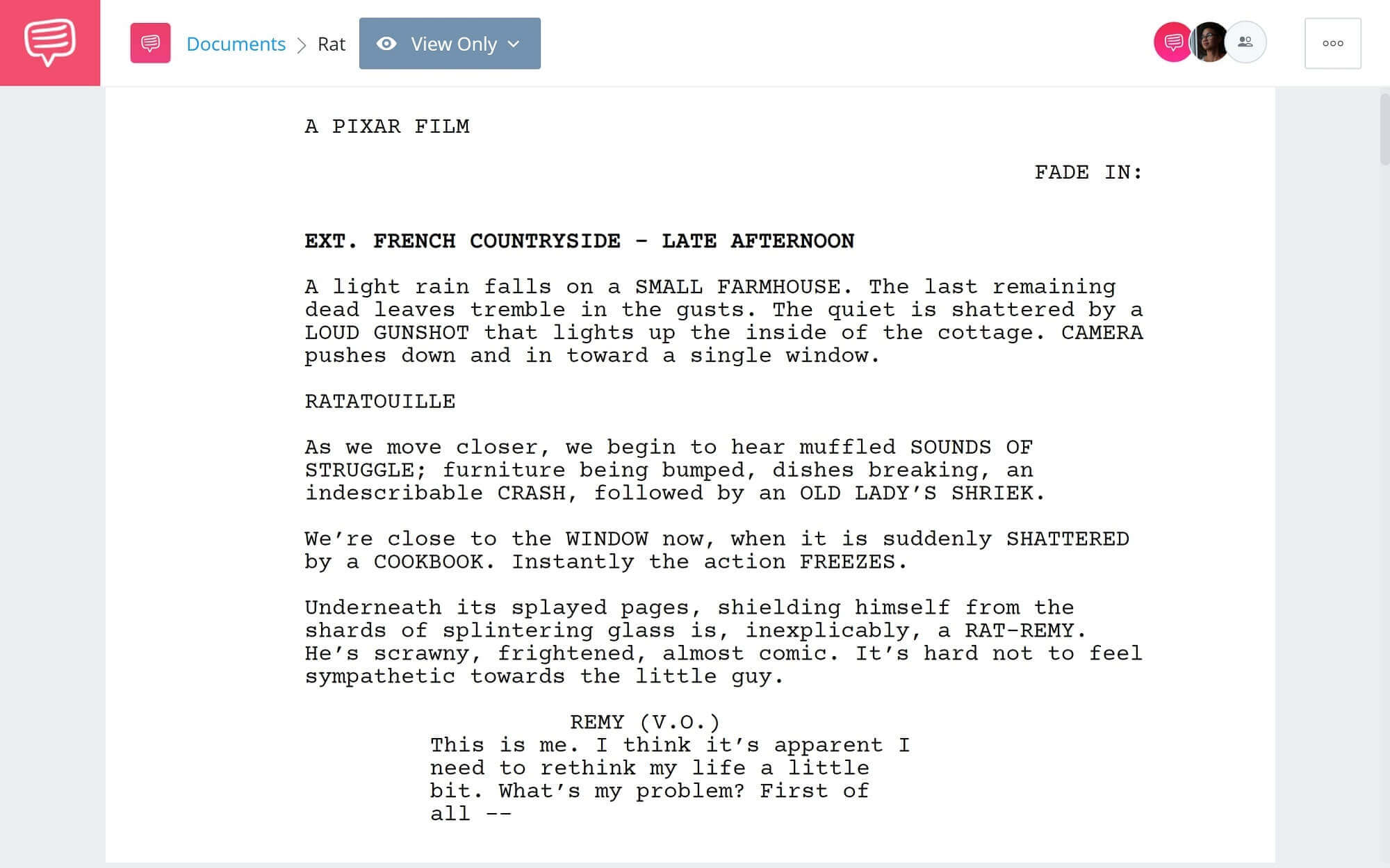
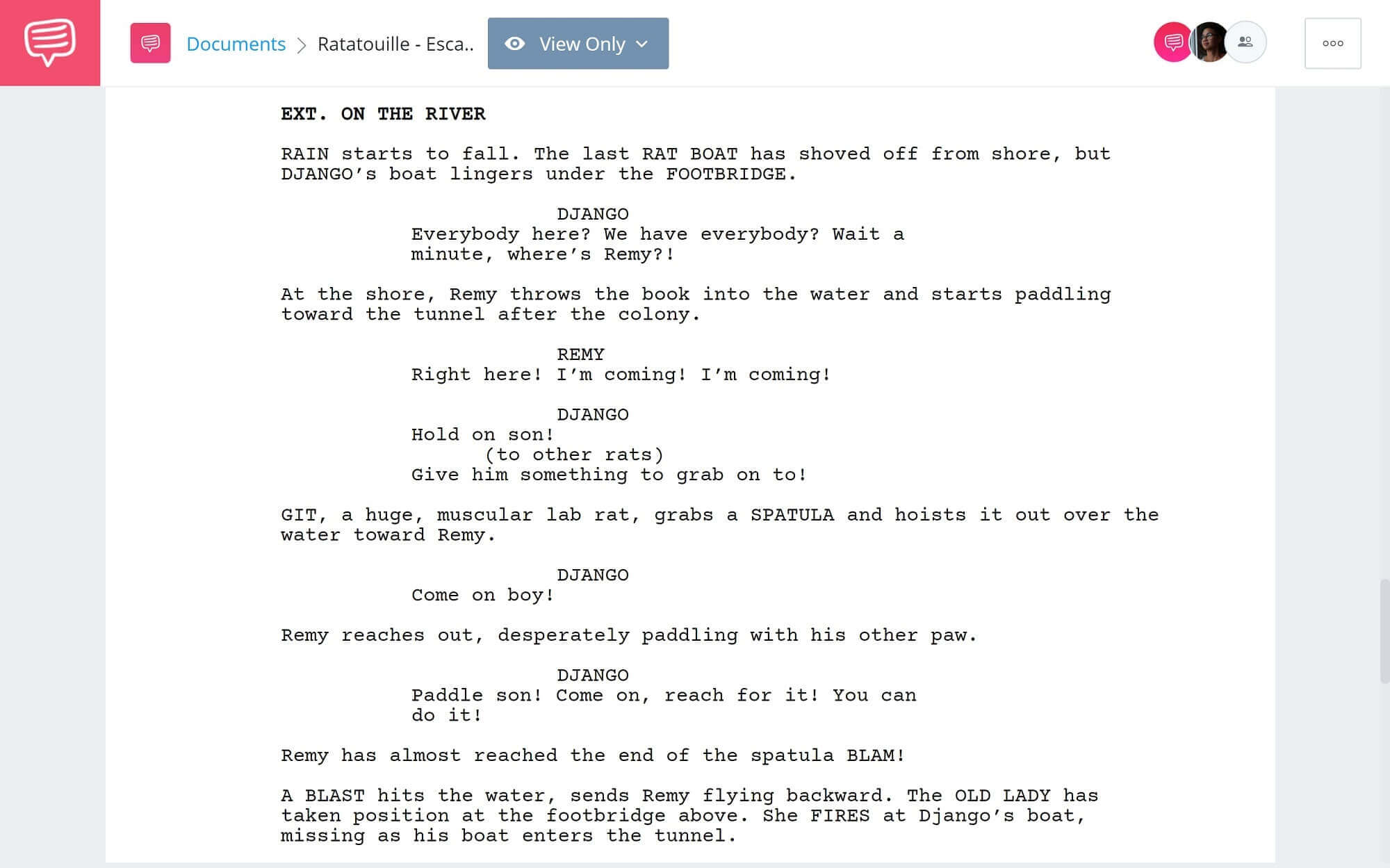
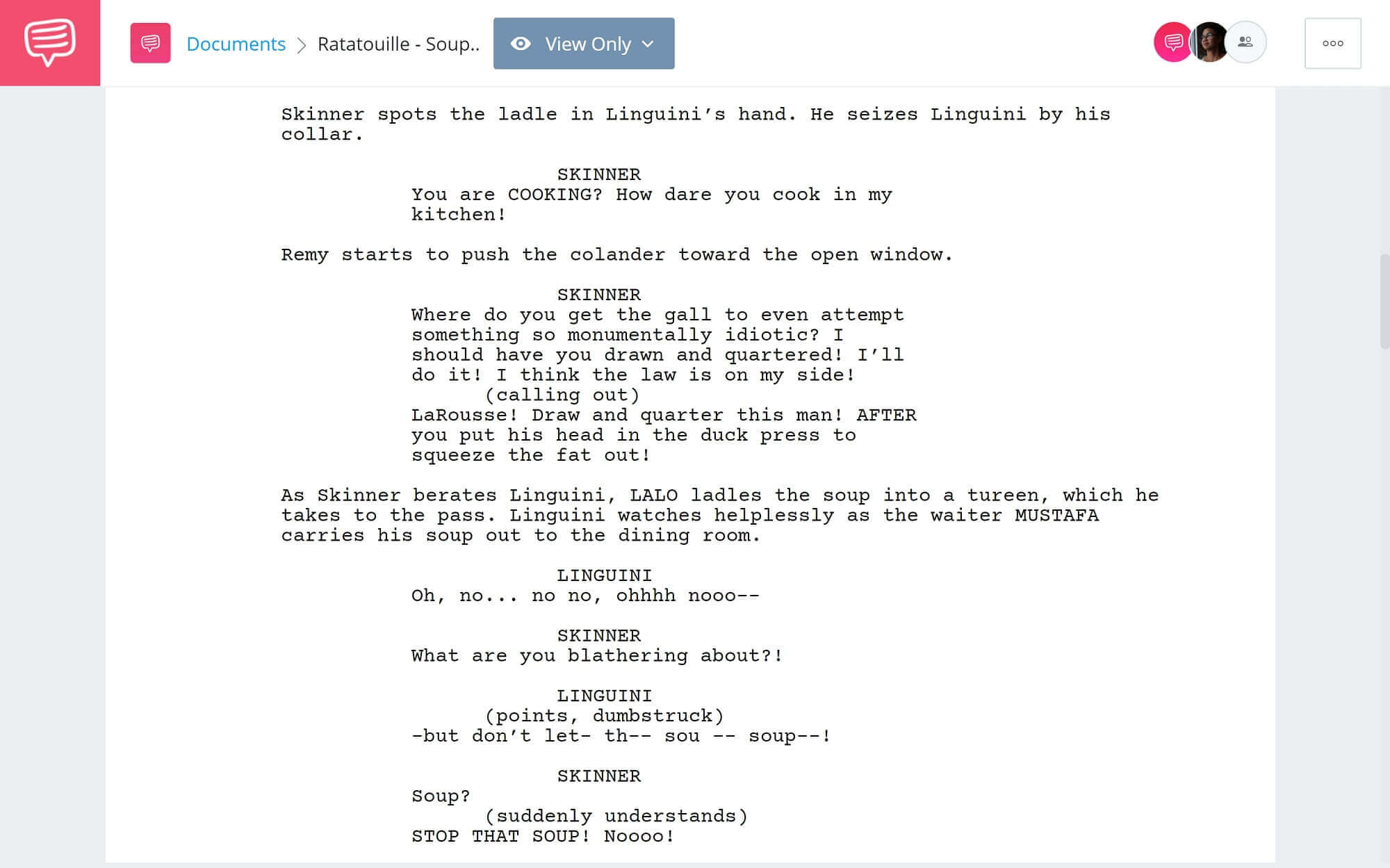
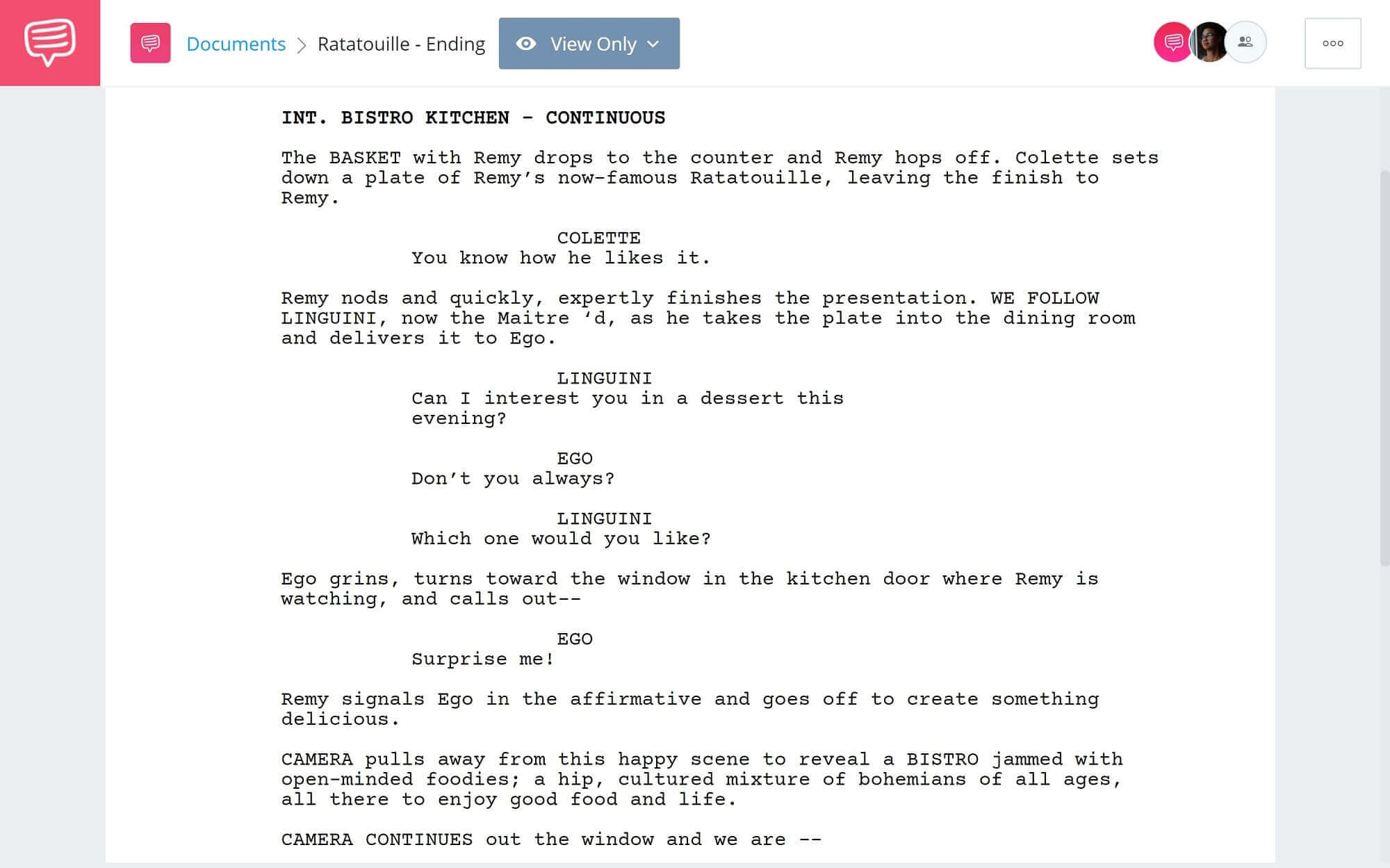
The breakdown shows plot point 2 twice. Should it be Plot point 3? Also can it come after midpoint or should it be called Build?